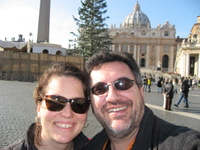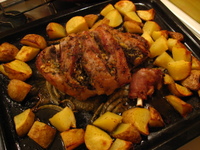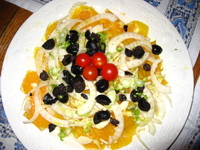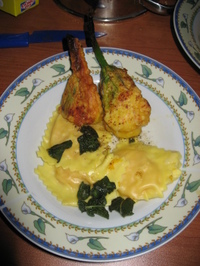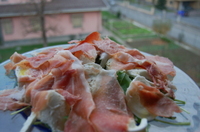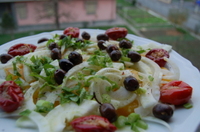 This week on Food For Thought, I presented some ideas of what to cook and drink in 2007 from some influential foodies. To listen to an MP3 of the show, click here. Barbara Fairchild of Bon Appetit magazine would like to see more people cook with ingredients from the North African country of Morocc o. Common spices used in Moroccan food include cinnamon, cumin, coriander and saffron. Preserved lemons, pine nuts and almonds also provide unique flavours and fragrant stews are often served over couscous, tiny grains of pasta. If you can’t find preserved lemons, they’re easy to make and you can choose from a few different recipes to make them at this link on Epicurious. Now here is the recipe for the lamb shanks I promised:
This week on Food For Thought, I presented some ideas of what to cook and drink in 2007 from some influential foodies. To listen to an MP3 of the show, click here. Barbara Fairchild of Bon Appetit magazine would like to see more people cook with ingredients from the North African country of Morocc o. Common spices used in Moroccan food include cinnamon, cumin, coriander and saffron. Preserved lemons, pine nuts and almonds also provide unique flavours and fragrant stews are often served over couscous, tiny grains of pasta. If you can’t find preserved lemons, they’re easy to make and you can choose from a few different recipes to make them at this link on Epicurious. Now here is the recipe for the lamb shanks I promised:
Braised Moroccan Lamb Shanks
(serves 4)
This dish is a ‘put-it-in-the-oven-and-forget-it-dish’ for the most part and is easily expandable to accommodate a crowd.
Ingredients:
4 large lamb shanks (ask for the really meaty parts)
2 tbsps. olive oil
2 preserved lemons, cut into 4 pieces each
8 pearl onions or shallots, peeled
4 medium carrots, peeled and cut into two pieces
1 large bulb of fennel cut into chunks (optional)
8 large cloves garlic, peeled
8 dried apricots
1 cinnamon stick
6 cardamom pods
salt and pepper to taste
1-2 cups red wine
Heat the olive oil over medium-high heat in a large ovenproof pot. Brown the shanks on all sides, then add all the lemons, vegetables and spices and enough red wine to cover the shanks. Cover the pot and put it into a 350-degree preheated oven for at least 2-3 hours. Check once an hour to see if you need to add any more wine, or water if preferred. The shanks are done when they are fork-tender and pulling away from the bone. Remove the cinnamon stick and the cardamom pods before serving. Serve in a bowl with the juices on top of couscous, or mashed potatoes.
And now a recipe for Fish Cuscus, which is a Sicilian dish which probably came to Italy via Morocco, when the Arabs invaded Sicily.
Fish Cuscus Serves 4
For the stock:
2 pounds fish trim
1/2 pound large shrimp or prawns, shell on
1 large carrot cut into 2 or 3 pieces
1/2 an onion, peeled
4 whole cloves
a few stalks of parsley
Peel the shrimp and reserve them for the final poaching. Put the shells, along with the fish trim, carrot, onion, cloves and parsley into a large pot and add cold water to cover. Bring to a boil, then simmer for 30 minutes. Remove from heat and strain out the solids.
For the cuscus:
1 cup hot fish stock
1 cup of instant couscous
Put the couscous in a large bowl and pour the hot stock over top. The couscous will swell and absorb the stock, and be ready to eat in about 5 minutes. Set aside for the final preparation.
2 tbsp. olive oil
1 carrot, sliced on the diagonal
1 stalk of celery, sliced on the diagonal
2 cloves of garlic, chopped
1/2 an onion, sliced
1/2 cup tomato juice or tomato passata (a thick puree of tomato available at Italian grocery stores)
1 cup fish stock
1 tsp. cinnamon
1/4 tsp. nutmeg
salt and pepper
1/2 pound fish fillets, such as red snapper or ling cod, cut into large chunks
In a large pot, heat the olive oil on medium-high heat. Add in the carrot, celery, onion and garlic. Stir and fry until the vegetables have started to soften. Stir in the tomato juice or passata, the fish stock and the spices. Then add the chunks of fish and the reserved shrimp or prawns. Simmer until the seafood is just cooked.
To serve, put a ladleful of couscous in each serving bowl. Then ladle some fish, prawns and liquid on top. (You can increase the number of servings by adding more fish, more stock and more tomato juice as you make up the final liquid base.)
 Vikram Vij and his wife Meeru Dhalwala own and operate a successful East Indian restaurant in Vancouver and just published their first cookbook. They would both like to see people getting back to using more BASIC ingredients. Meeru says use real onions, tomatoes and fresh herbs instead of packaged and processed foods. Vikram wants people to buy whole chickens and cut them up, learn how the animal is put together and use different cuts for different dishes, don’t lose the flavour you can get by cooking meat on the bone.
Vikram Vij and his wife Meeru Dhalwala own and operate a successful East Indian restaurant in Vancouver and just published their first cookbook. They would both like to see people getting back to using more BASIC ingredients. Meeru says use real onions, tomatoes and fresh herbs instead of packaged and processed foods. Vikram wants people to buy whole chickens and cut them up, learn how the animal is put together and use different cuts for different dishes, don’t lose the flavour you can get by cooking meat on the bone.
For Eric Akis, cookbook author and food editor of the Victoria Times-Colonist newspaper, colour makes the case for his 2007 ingredient choices. He says choosing brightly coloured fruits and vegetables like red peppers, cranberries and carrots will not only brighten up your plate but also boost your intake of antioxidants.
 Someone who also espouses a basic ingredient philosophy is Ricardo Larrivee of the Food Network and Ricardo magazine. He says how you shop goes deeper than what you want to eat. He advocates buying local produce and artisanal products, be they honey, cheese, whatever. But buy from the small producers, from the people who can’t afford to advertise their products, people who are just getting by.
Someone who also espouses a basic ingredient philosophy is Ricardo Larrivee of the Food Network and Ricardo magazine. He says how you shop goes deeper than what you want to eat. He advocates buying local produce and artisanal products, be they honey, cheese, whatever. But buy from the small producers, from the people who can’t afford to advertise their products, people who are just getting by.
And for wine lovers, Canadian wine writer Tony Aspler recommends getting more into sparkling wines on an everyday basis, and that doesn’t necessarily mean champagne. Tony suggests trying proseccos from Italy, cavas from Spain and Australia is making some nice bubble as well. His next big white wine? Chenin blanc. And in red? Gamay, the grape that is used to make Beaujolais can be chilled to bring up its acidity to be served with fish, or poured at room temperature to make a perfect foil for meat, a well-rounded versatile wine. What are your food or wine resolutions for 2007? Feel free to post a comment below…

